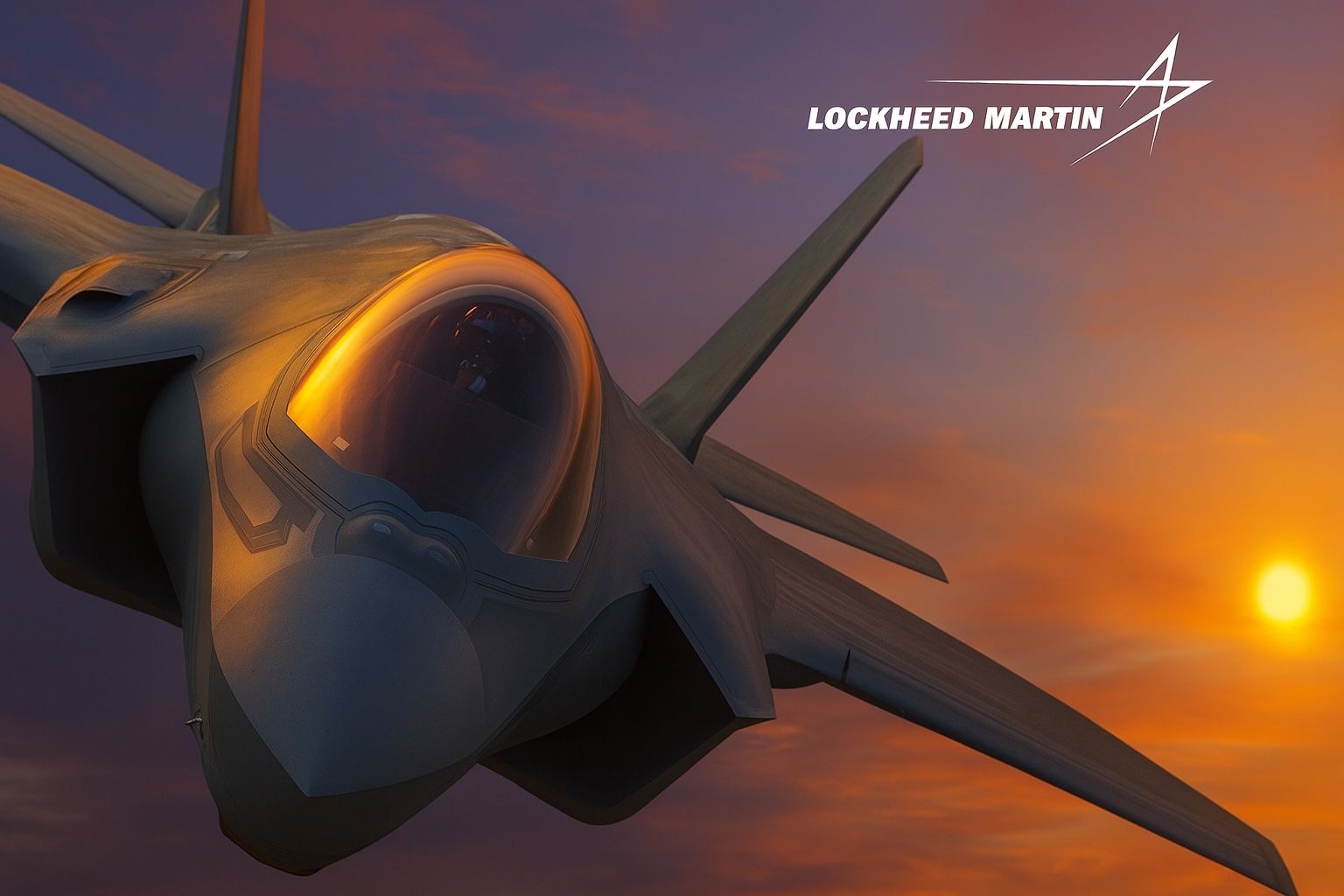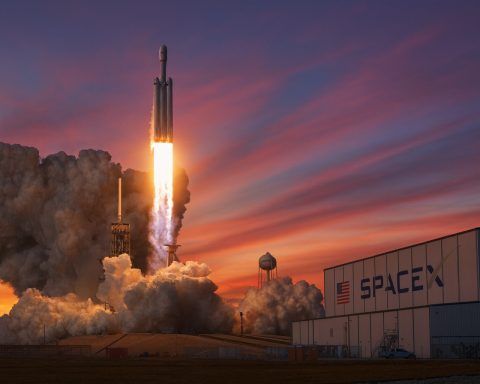Key Facts (Oct 1–10, 2025)
- Major Defense Deals Finalized: Lockheed Martin and the Pentagon sealed a $24.3 billion F-35 contract for 296 jets in production Lots 18–19 [1] [2], ending two years of negotiations. A separate $647 million Navy contract for Trident II D5 missiles was also awarded [3].
- Successful Weapon Tests: The U.S. Army completed soldier-led flight tests of Lockheed’s Precision Strike Missile (PrSM), firing multiple rockets from HIMARS and MLRS launchers for the first time [4]. Lockheed called it a key milestone in delivering “long-range target neutralization capabilities” to soldiers [5].
- Space & Aerospace Highlights: During World Space Week (Oct 4–10), Lockheed Martin Space President Robert Lightfoot served as Honorary Chair [6], underscoring the company’s leadership in space exploration. NASA and Lockheed’s Skunk Works progressed toward a first flight of the X-59 QueSST supersonic demonstrator by year-end [7] [8], conducting high-speed taxi tests in Palmdale.
- Financial Signals: Lockheed scheduled its Q3 2025 earnings release and webcast for Oct. 21 [9]. The company’s stock hovered around $500 per share in early October, rebounding ~23% from its 52-week low [10]. Analysts note the stock is still ~18% below last year’s peak, but point to a record $166 billion backlog and steady growth forecasts (~5% revenue growth in 2025) [11] [12].
- Geopolitical & Policy Moves: A U.S. government shutdown beginning Oct 1 shut NASA and other agencies [13], though Pentagon operations continued. Meanwhile, U.S. allies ramped up arms deals: the State Department approved a $1.75 billion sale of 20 Lockheed HIMARS launchers to Canada [14] and a $705 million HIMARS sale to Australia [15] to bolster allied firepower amid global tensions.
Corporate Announcements & Innovations
Lockheed Martin kicked off October with key company news. On October 1, the firm announced a successful series of U.S. Army flight tests of its new Precision Strike Missile (PrSM) [16]. In late September, soldiers at White Sands Missile Range fired PrSMs from both a HIMARS launcher and a modernized M270A2 rocket launcher, marking the first dual-launcher operational test [17]. “This milestone validates the soldier’s ability to fire PrSM from all platforms… and certifies mission readiness,” said Carolyn Orzechowski, Lockheed’s VP of Precision Fires, noting the company is “pushing the boundaries of innovation” to deliver advanced long-range strike capabilities [18]. The tests demonstrated PrSM’s extended 400+ km reach and accuracy, aligning with the Army’s modernization goals [19]. This successful demo brings the next-generation missile closer to fielding as a 21st Century Security® solution for U.S. forces.
Also on Oct. 1, Lockheed issued a financial announcement for investors. The company scheduled its third-quarter 2025 earnings release and webcast for Oct. 21 [20]. Chairman and CEO Jim Taiclet and CFO Evan Scott will host the call to discuss Q3 results and field questions [21]. (Lockheed traditionally reports Q3 earnings in late October; results will be posted that morning before markets open [22].) This signals that despite recent one-time charges, the company remains on track to meet its full-year outlook. In fact, CFO Evan Scott has emphasized that Lockheed is actively addressing prior program challenges to prevent repeat charges. “We have a focused team…working to prevent charges like this going forward… We’re confident over the long term we can manage these issues and continue delivering for the customer and our shareholders,” Scott said after Q2’s write-downs [23]. Investors and analysts will watch the Q3 webcast for updates on key programs and 2025 guidance.
Defense Contracts and Military Programs
Lockheed Martin landed several major defense contracts as the new fiscal year began. Most prominently, the Pentagon’s F-35 Joint Program Office and Lockheed finalized a $24.3 billion agreement on September 30 for the next batches of F-35 Lightning II fighters [24]. This mega-deal – formally announced on Oct. 1 – covers 296 F-35 jets (148 aircraft in Lot 18 and 148 in Lot 19) for U.S. and international customers [25]. It concludes protracted negotiations that had stretched since 2023. Deliveries under this two-lot contract will begin in 2026 [26]. Lockheed’s F-35 vice president Chauncey McIntosh hailed the deal, saying it “represents continued confidence in the most affordable and capable fighter… We are proud to support our customers and further solidify the F-35’s role in enabling peace through strength.” [27] [28]. Notably, Lockheed said the per-jet price increase in these new lots is held below the rate of inflation [29] [30], even as material costs have risen – suggesting efficiencies to keep the fifth-generation stealth fighter cost-competitive. The contract’s scope includes only the airframes; engine contracts (with Pratt & Whitney/RTX) are handled separately [31]. Alongside the main award, the Pentagon issued several smaller F-35 support contracts, including $101 million for spare parts to mitigate potential supply chain shortages and ~$137 million for engineering changes on Lot 17 jets [32]. These moves aim to sustain the F-35 fleet’s readiness as global demand for the jet remains strong (over 1,230 F-35s are in service across 12 nations) [33].
In the strategic weapons arena, Lockheed’s Missiles & Space division scored a significant win with the U.S. Navy. On Oct. 2, the Department of Defense confirmed a $647 million contract modification for Lockheed Martin Space to produce additional Trident II D5 submarine-launched ballistic missiles and provide support services [34]. The award adds onto an earlier letter contract, now bringing the total value to as high as $745 million if all options are exercised [35]. It extends Lockheed’s decades-long role as prime contractor for the Trident II Strategic Weapon System [36], which arms U.S. Navy Ohio-class and UK Vanguard-class nuclear submarines. Work will span multiple states (Florida, Georgia, Utah, etc.) through 2030 [37]. The contract also benefits America’s closest ally – it includes Foreign Military Sales support to the United Kingdom’s Trident program [38]. This reflects Lockheed’s continuing transatlantic collaboration on strategic deterrence. The Navy contract follows other recent boosts to Trident: in August, Lockheed received $111 million for ongoing D5 production and in February a $383 million award for modernizing the missile to extend its service life [39]. These investments underscore the Pentagon’s commitment to nuclear deterrence capabilities, with Lockheed at the core.
Lockheed’s Rotary and Mission Systems unit (Sikorsky) also entered FY2026 with momentum (just prior to Oct 1). In late September, the U.S. Marine Corps awarded Sikorsky a five-year contract worth up to $10.8 billion to build as many as 99 CH-53K King Stallion heavy-lift helicopters [40]. This multi-year deal, announced Sept. 26, will stabilize the production line and ensure consistent deliveries of the CH-53K – a cornerstone of the Marines’ future heavy lift, capable of hauling 27,000+ lbs. The contract was “a big victory for Sikorsky and helps stabilize [the] U.S. industrial base”, according to Lockheed’s release [41]. While this award fell just before the October window, it set the stage for Lockheed’s Q4 and merits note as part of the company’s recent contract haul. Together, the F-35, Trident, and CH-53K programs contribute significantly to Lockheed’s record-high backlog of orders (over $165 billion as of mid-2025) [42] [43], positioning the firm for solid revenue in years ahead.
Aerospace and Space-Related Activities
Lockheed Martin’s influence extends beyond defense into civil and space endeavors, and early October saw notable developments. NASA’s X-59 QueSST program – a partnership with Lockheed’s famed Skunk Works – progressed toward a milestone first flight. According to NASA officials, the X-59 quiet supersonic jet completed low- and medium-speed taxi tests and was entering high-speed taxi trials in Palmdale, CA as of late September [44] [45]. The X-59 is an experimental single-pilot aircraft designed to produce a “quiet thump” instead of a sonic boom [46]. Its goal: demonstrate supersonic flight that could be acceptable over land, potentially leading to lifting the civilian supersonic flight ban. The project has faced delays (initially expected to fly in 2021), but NASA affirmed in September that “The X-59 is set to fly in 2025.” [47] Engineers are mapping out the maiden flight, which will involve a gradual climb and subsonic loop before later tests push to Mach 1.4 [48]. Lockheed’s team has integrated numerous safety features (redundant hydraulics, emergency engine restart systems) to ensure the pilot’s safety as the jet will cruise at 59,000 feet [49] [50]. With Skunk Works as the lead contractor, the X-59’s impending first flight will mark an aerospace milestone demonstrating Lockheed’s continued innovation in cutting-edge flight technology.
Lockheed Martin was also front and center during World Space Week 2025 (Oct 4–10). This year’s global celebration of space had the theme “Living in Space,” highlighting sustainable exploration and habitation. Fittingly, the Honorary Chair of World Space Week 2025 was Robert Lightfoot, President of Lockheed Martin Space [51]. Lightfoot – a former NASA acting Administrator now heading Lockheed’s space division – used the platform to emphasize international collaboration and the rapid innovation needed in the space sector. In public remarks (echoing his comments at September’s Air, Space & Cyber Conference), Lightfoot stressed that space is now a contested domain and adversaries’ long-range threats are growing [52]. He urged “swift investment in… layered homeland defense architecture” and faster delivery of space-based assets for programs like “Golden Dome for America” (a proposed next-gen missile defense network) [53] [54]. Lockheed is leveraging existing capabilities – for example, adapting its advanced GPS IIIF satellites – to speed up such architectures [55]. The company’s new Small Satellite Processing Center is scaling production of small sats to get critical tech on orbit quickly [56]. By championing speed and partnerships, Lightfoot positioned Lockheed at the forefront of both protecting space assets and using space to protect the homeland. His role during World Space Week underscored Lockheed Martin’s dual commitment to exploration (like NASA’s Orion moon spacecraft, built by Lockheed) and national security in space.
No major Lockheed-related space launches occurred in early October, but the company’s satellite programs saw continued activity. The U.S. Space Force’s GPS constellation – largely built by Lockheed – received a new addition in late September, when the GPS III SV08 satellite (built by Lockheed in Littleton, CO) was launched aboard a SpaceX Falcon 9 [57] [58]. That launch (on Sept. 30) was notable for its rapid turnaround: only ~3 months from call-up to liftoff, reflecting streamlined processes to deploy GPS assets faster [59]. Lockheed’s satellite was pulled from storage in February and ready to launch by May [60] – a success story in responsive space capability. Additionally, Lockheed continues development of NASA’s Orion spacecraft for the Artemis lunar missions. With the Orion for Artemis II already completed and delivered to NASA in mid-2025 [61], Lockheed is now building future Orion capsules for Artemis III and beyond [62], focusing on cost reduction and safety. In summary, while early October didn’t feature new launches by Lockheed, the period highlighted the company’s broad space portfolio: from human spaceflight vehicles and satellite innovation to thought leadership in how space technology can address emerging threats.
Financial Performance and Stock Market Update
Lockheed Martin’s financial picture in early October reflected a mix of stability and anticipation. The company’s stock (NYSE: LMT) traded around multi-month highs, buoyed by strong defense demand. On October 3, LMT shares closed near $504, up about 1% for the day [63]. This price marked a robust rebound of +23% from the stock’s 52-week low of ~$410 [64], achieved earlier in 2025 when market sentiment was weaker. However, the stock remained roughly 18% below its 1-year peak (~$619) [65], indicating there is still ground to recover to last year’s highs. Over the past year Lockheed’s stock underperformed the broader market (down ~16% year-over-year) [66], largely due to a second-quarter earnings miss driven by one-time charges. Those Q2 2025 charges – totaling $1.6 billion on a classified Aeronautics program and two Sikorsky helicopter contracts – had temporarily depressed earnings [67] [68]. Consequently, Lockheed’s trailing P/E ratio appeared elevated (~28x) [69], but analysts note this was a distortion; the forward P/E of ~22 more accurately reflects its normal valuation [70].
Investors now seem to be looking past those charges, focusing on Lockheed’s record order backlog and future revenue stream. The company ended Q2 with a $166.5 billion total backlog [71] – spanning fighter jets, missiles, helicopters, and space systems – which was up significantly from a year prior. This backlog provides multi-year visibility: for context, Lockheed’s 2024 sales are around $66–67 billion, so a $166B backlog is roughly 2.5 years of revenue. In addition, Lockheed’s management reaffirmed full-year 2025 guidance of $74 billion in sales and solid cash flow despite the Q2 setback [72]. Wall Street analysts project Lockheed’s top line to grow ~5% in 2025 and ~4% in 2026, modest but steady expansion in line with defense budget trends [73]. Earnings are expected to rebound as those troubled programs are turned around. Notably, Lockheed continues to reward shareholders: it pays a hefty dividend of $13.20 per share annually (about 2.7% yield), which has doubled over the past decade [74]. The company also authorized $6 billion in share buybacks for 2025 [75] (part of its capital return strategy). These factors contribute to mostly bullish sentiment – as of early October, ~13 analysts tracked by Reuters and Yahoo Finance rate LMT as a “Hold” to mild “Buy”, with an average 12-month price target around the high-$480s [76] [77] (near the current trading range). In sum, Lockheed Martin’s stock performance in this period reflects investor confidence in its defense franchise, balanced by caution as the company works through program challenges. All eyes will be on the Q3 earnings report due Oct. 21 for updates on profit margins and any adjustments to the outlook.
Public Policy, Government Relations, and Geopolitics
Early October brought significant public policy and geopolitical currents that entwine with Lockheed Martin’s business. At the forefront was the drama in Washington, D.C.: on October 1, the U.S. federal government entered a partial shutdown after funding lapsed amid political standoffs [78]. By October 3, agencies like NASA remained closed and hundreds of thousands of federal employees were furloughed [79]. Defense contractors like Lockheed felt ripples too. The Department of Defense, deemed essential, continued operating – meaning active military contracts (especially those funded by prior appropriations) proceeded, and uniformed personnel remained at work. However, certain contracting activities and civilian-led programs faced delays. For example, NASA’s projects with Lockheed (like the Orion spacecraft and other space tech development) were largely paused during the shutdown. Lockheed Martin’s leadership did not issue any dramatic public statements during this brief funding gap, but defense industry groups urged Congress to resolve the impasse. Prolonged shutdowns can disrupt contract awards, stop payments on some R&D programs, and slow regulatory approvals. Fortunately, by mid-October a compromise was in sight: Congress signaled intentions to pass a Continuing Resolution to restore funding through November [80] [81]. The shutdown episode highlighted Lockheed’s reliance on stable government funding – a point CEO Jim Taiclet and others have often made when warning that budget uncertainty poses a risk to defense readiness.
On the geopolitical front, Lockheed Martin continued to be at the center of international defense relations. U.S. allies accelerated purchases of American weaponry – much of it made by Lockheed – amid regional security concerns. Notably, on Oct. 1 the U.S. State Department approved a major Foreign Military Sale to Canada: a package of M142 High Mobility Artillery Rocket Systems (HIMARS) and related equipment valued at up to $1.75 billion [82]. The deal, pending Congressional nod, would furnish the Canadian Army with 20 HIMARS launchers, dozens of rockets, support vehicles, and training. Canada’s interest in HIMARS underscores lessons from recent conflicts (Ukraine’s success with HIMARS) and aims to bolster NATO interoperability. A day earlier, on Sept. 30, the State Department similarly cleared a $705 million sale of HIMARS to Australia (potentially 22 launchers plus munitions) [83]. As the maker of HIMARS, Lockheed stands to benefit directly if those sales proceed. And there’s more: in mid-September, the U.S. approved a $780 million sale of Javelin anti-tank missiles to Poland [84] – Javelin is a joint Lockheed-Raytheon product, again reflecting high demand among U.S. allies reinforcing their defenses. These FMS approvals align with the Biden (and now Trump) administration’s push to arm partners and share the security burden, which President Trump has tied into his “Golden Dome” missile defense vision. In fact, President Trump remarked that the U.S. will “increase military sales to India… [and] eventually provide F-35 fighter jets” as ties deepen [85], indicating potential long-term opportunities for Lockheed in India (though a recent tariff spat caused India to pause some U.S. arms purchases [86] [87]).
Finally, Lockheed’s engagement in public discourse and policy was evident through its executives. In addition to Robert Lightfoot’s advocacy for faster space-defense innovation (noted above), the company’s CEO Jim Taiclet has been vocal on sustaining the U.S. defense industrial base. In an interview on Sept. 22, Taiclet emphasized the need for predictable budgets and quicker acquisition processes, warning that the U.S. must “check off [the] agenda” of rebuilding stockpiles and investing in new technologies to stay ahead [88]. He also weighed in on emerging defense initiatives: for example, discussing President Trump’s proposed “Golden Dome” nationwide missile defense shield, Taiclet expressed that integrating capabilities like Lockheed’s PAC-3 MSE interceptors and space sensors could “increasingly protect the U.S. against hypersonic threats.” [89] [90] Lockheed’s recent $9.8 billion PAC-3 missile order – the largest ever for Patriot interceptors [91] [92] – feeds directly into such efforts to upgrade air and missile defenses for the U.S. and its allies. The PAC-3 MSE is a cutting-edge missile (~$4M each) that proved itself intercepting ballistic missiles in the Ukraine conflict, and it’s central to both U.S. Army and European air defense modernization [93] [94]. Taiclet’s commentary and Lockheed’s ongoing contracts demonstrate the company’s alignment with U.S. policy goals: deterring aggression through strength and providing advanced capabilities to friends and allies.
Expert Commentary and Industry Outlook
Industry experts and analysts used this period to weigh in on Lockheed Martin’s trajectory. The consensus: despite some near-term hurdles, the outlook remains solid for the world’s largest defense contractor. “Lockheed had a rough second quarter… The stock is essentially flat this year… But this fight’s not over,” wrote Motley Fool defense analyst Patrick Sanders, likening Lockheed to a resilient boxer staging a comeback [95] [96]. Sanders noted that Lockheed is still “stacking up wins” – citing the multi-billion contracts for CH-53K helicopters and Patriot missiles, and a new Army battle management system prototype award – all announced in the past few weeks [97]. These wins boosted Lockheed’s backlog and signal confidence from its core customer (the U.S. Department of Defense). The company now has “a lot left in the tank,” in Sanders’ view, especially given its broad portfolio of programs like the F-35, which enjoy bipartisan support and international demand.
Wall Street analysts generally agree that Lockheed’s fundamentals are strong. Bank of America reiterated its Buy rating in early October, arguing that Lockheed is well-positioned in a world of rising geopolitical risk. They pointed to growing defense budgets in the U.S., Europe, and Asia-Pacific that should benefit top contractors. Lockheed’s exposure across air, land, sea, and space domains provides a diversified revenue base. One area of excitement is hypersonic weapons: Lockheed is developing boost-glide missiles and says it is “leveraging digital engineering to accelerate new hypersonic capabilities,” per recent investor presentations [98]. If these technologies mature, they could open significant new revenue streams by late this decade. Additionally, Morgan Stanley analysts at a September 2025 conference highlighted Lockheed’s investments in autonomy and artificial intelligence to enable joint all-domain operations – aligning with Pentagon priorities [99].
However, experts also caution about challenges. Byron Callan, a noted defense analyst at Capital Alpha Partners, warned that execution risk remains on big programs (citing the classified aircraft program that caused charges). In his note to clients, Callan wrote that investors will want to see “evidence of better cost control and program management” in the upcoming earnings before fully crediting Lockheed’s turnaround efforts. There is also the matter of the political environment: while defense spending has been rising, Washington’s budget battles (as seen with the shutdown and competing priorities) could introduce uncertainty. Lockheed’s heavy reliance on U.S. government orders (roughly 74% of revenue) means it is sensitive to any major shifts in Pentagon strategy or appropriations. Nonetheless, no drastic cuts are anticipated in the near term – if anything, global conflicts have bolstered the case for maintaining or increasing defense budgets.
Importantly, Lockheed’s leadership exudes confidence about meeting future needs. CEO Jim Taiclet has articulated a vision of Lockheed as a “21st Century Security” company pivoting into new tech areas like 5G, cybersecurity, and even civil applications (e.g. energy management with its nuclear fusion research). During a Council on Foreign Relations speaker event, Taiclet noted Lockheed’s R&D in directed energy weapons and advanced satellites, and emphasized partnerships with tech firms to integrate commercial innovation [100] [101]. This suggests Lockheed is preparing for the defense landscape of the 2030s, which analysts believe will increasingly blend traditional platforms with software-driven, network-centric solutions.
In summary, expert commentary between Oct 1 and 10, 2025 paints a picture of cautious optimism. Lockheed Martin is seen as regaining its footing after a one-off stumble, backed by a surge of new contracts and enduring demand for its flagship programs. The company’s own executives, from the CEO to division presidents, are actively shaping the narrative that Lockheed is indispensable to both America’s defense and its spacefaring future. As a result, many analysts call Lockheed “a top defense pick” going into 2026 – citing its strong balance sheet, hefty backlog, and a dividend that pays investors to wait for the next upward cycle [102] [103]. The coming weeks (with Q3 results and any updates on programs like the F-35, NGAD, or hypersonics) will be closely watched, but the developments of early October have reinforced Lockheed Martin’s standing as a bedrock of the defense industry, adapting to meet the challenges of a volatile world.
Sources: Official Lockheed Martin press releases [104] [105]; U.S. Department of Defense contract notices [106]; Defense News and Breaking Defense reports [107] [108]; GovCon Wire [109]; Reuters News [110] [111]; SpacePolicyOnline [112]; Defense Security Cooperation Agency (DSCA) releases [113] [114]; Motley Fool/Nasdaq analysis [115] [116]; WallStreetZen stock data [117]; Executive remarks via ExecutiveBiz [118] [119] and Finance Yahoo/MarketBeat [120].
References
1. breakingdefense.com, 2. www.defensenews.com, 3. www.war.gov, 4. news.lockheedmartin.com, 5. news.lockheedmartin.com, 6. www.worldspaceweek.org, 7. www.flightglobal.com, 8. www.flightglobal.com, 9. news.lockheedmartin.com, 10. www.wallstreetzen.com, 11. www.nasdaq.com, 12. www.nasdaq.com, 13. spacepolicyonline.com, 14. www.dsca.mil, 15. www.dsca.mil, 16. news.lockheedmartin.com, 17. news.lockheedmartin.com, 18. news.lockheedmartin.com, 19. news.lockheedmartin.com, 20. news.lockheedmartin.com, 21. news.lockheedmartin.com, 22. news.lockheedmartin.com, 23. www.nasdaq.com, 24. breakingdefense.com, 25. breakingdefense.com, 26. breakingdefense.com, 27. breakingdefense.com, 28. www.defensenews.com, 29. www.defensenews.com, 30. www.defensenews.com, 31. breakingdefense.com, 32. www.defensenews.com, 33. www.defensenews.com, 34. www.war.gov, 35. www.govconwire.com, 36. www.govconwire.com, 37. www.govconwire.com, 38. www.war.gov, 39. www.govconwire.com, 40. news.lockheedmartin.com, 41. news.lockheedmartin.com, 42. www.nasdaq.com, 43. www.nasdaq.com, 44. www.flightglobal.com, 45. www.flightglobal.com, 46. www.flightglobal.com, 47. www.flightglobal.com, 48. www.flightglobal.com, 49. www.flightglobal.com, 50. www.flightglobal.com, 51. www.worldspaceweek.org, 52. www.executivebiz.com, 53. www.executivebiz.com, 54. www.executivebiz.com, 55. www.executivebiz.com, 56. www.executivebiz.com, 57. spaceflightnow.com, 58. spaceflightnow.com, 59. spaceflightnow.com, 60. spaceflightnow.com, 61. www.facebook.com, 62. www.lockheedmartin.com, 63. www.wallstreetzen.com, 64. www.wallstreetzen.com, 65. www.wallstreetzen.com, 66. www.wallstreetzen.com, 67. www.nasdaq.com, 68. www.nasdaq.com, 69. www.nasdaq.com, 70. www.nasdaq.com, 71. www.nasdaq.com, 72. successknocks.com, 73. www.nasdaq.com, 74. www.nasdaq.com, 75. successknocks.com, 76. public.com, 77. public.com, 78. spacepolicyonline.com, 79. spacepolicyonline.com, 80. spacepolicyonline.com, 81. spacepolicyonline.com, 82. www.dsca.mil, 83. www.dsca.mil, 84. www.dsca.mil, 85. www.reuters.com, 86. www.reuters.com, 87. www.reuters.com, 88. www.facebook.com, 89. www.reuters.com, 90. www.reuters.com, 91. www.reuters.com, 92. www.reuters.com, 93. www.reuters.com, 94. www.reuters.com, 95. www.nasdaq.com, 96. www.nasdaq.com, 97. www.nasdaq.com, 98. news.lockheedmartin.com, 99. www.executivebiz.com, 100. www.foxbusiness.com, 101. www.executivebiz.com, 102. seekingalpha.com, 103. www.nasdaq.com, 104. news.lockheedmartin.com, 105. news.lockheedmartin.com, 106. www.war.gov, 107. www.defensenews.com, 108. www.defensenews.com, 109. www.govconwire.com, 110. www.reuters.com, 111. www.reuters.com, 112. spacepolicyonline.com, 113. www.dsca.mil, 114. www.dsca.mil, 115. www.nasdaq.com, 116. www.nasdaq.com, 117. www.wallstreetzen.com, 118. www.executivebiz.com, 119. www.executivebiz.com, 120. public.com





